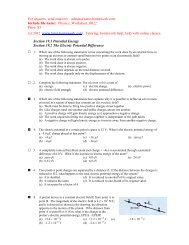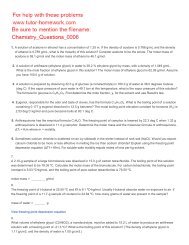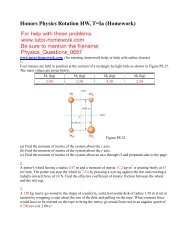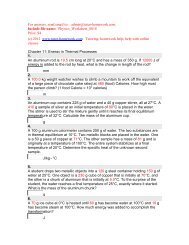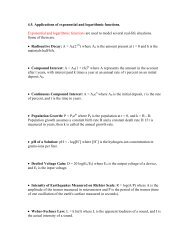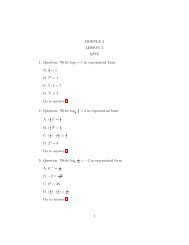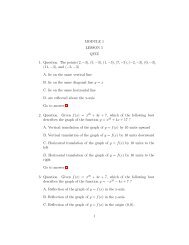You also want an ePaper? Increase the reach of your titles
YUMPU automatically turns print PDFs into web optimized ePapers that Google loves.
For answers, send email to: admin@tutor-homework.<strong>com</strong>.<br />
Include file name: Physics_Worksheet_0027<br />
Price: $3<br />
(c) 2012 www.tutor-homework.<strong>com</strong>: <strong>Tutor</strong>ing, homework help, help with online classes.<br />
5. Daniel walks directly toward a plane mirror at a speed of 0.25 m/s. Determine the speed of the<br />
image relative to him.<br />
(a) 0.13 m/s (c) 0.50 m/s (e) 1.0 m/s<br />
(b) 0.25 m/s<br />
(d) 0.75 m/s<br />
• 6.<br />
Five balls labeled A, B, C, D, and E are placed<br />
in front of a plane mirror as shown in the figure.<br />
Which ball(s) will the observer see reflected in<br />
the mirror?<br />
(a) A only<br />
(b) C only<br />
(c) A and B<br />
(d) A, B, D and E<br />
(e) A, B, C, D and E<br />
Plane mirror<br />
A B C<br />
D E<br />
<strong>Section</strong> 25.4 Spherical Mirrors<br />
<strong>Section</strong> 25.5 The Formation of Images by Spherical<br />
Mirrors<br />
Only the<br />
left eye<br />
is closed.<br />
13. The focal length of a spherical concave mirror is 20 cm. What is<br />
its radius of curvature?<br />
(a) 5 cm (c) 20 cm (e) 50 cm<br />
(b) 10 cm<br />
(d) 40 cm<br />
14. The radius of curvature of a spherical convex mirror is 52 cm. What is its focal length?<br />
(a) +26 cm (c) +52 cm (e) +104 cm<br />
(b) –26 cm<br />
(d) –52 cm<br />
15. Which one of the following statements concerning a convex mirror is true?<br />
(a) A convex mirror can form a real image.<br />
(b) A convex mirror must be spherical in shape.<br />
(c) The image produced by a convex mirror will always be inverted relative to the object.<br />
(d) A convex mirror produces a larger image than a plane mirror does for the same object<br />
distance.<br />
(e) The image a convex mirror produces is closer to the mirror than it would be in a plane<br />
mirror for the same object distance.<br />
16. A concave mirror has a radius of curvature of 30.0 cm. How close to the mirror should an object<br />
be placed so that the rays travel parallel to each other after reflection?<br />
(a) 10.0 cm (c) 30.0 cm (e) 60.0 cm<br />
(b) 15.0 cm<br />
(d) 45.0 cm<br />
Questions 20 through 22 pertain to the system described below:
256 Chapter 25 Reflection of Light: Mirrors<br />
An object is placed in front of a concave spherical<br />
mirror as shown below. The three rays 1, 2, and<br />
3, leave the top of the object and, after reflection,<br />
converge at a point on the top of the image. Ray<br />
1 is parallel to the principal axis, ray 2 passes<br />
through F, and ray 3 passes through C.<br />
3<br />
1<br />
C<br />
2<br />
F<br />
20. Which ray(s) will pass through F after reflection?<br />
(a) 1 only (c) 3 only (e) 1, 2, and 3<br />
(b) 2 only (d) both 1 and 2<br />
21. Which ray(s) will reflect back on itself (themselves)?<br />
(a) 1 only (c) 3 only (e) 1, 2, and 3<br />
(b) 2 only (d) both 1 and 2<br />
22. Which one of the following groups of terms best describes the image?<br />
(a) real, upright, enlarged<br />
(d) real, inverted, enlarged<br />
(b) real, inverted, reduced<br />
(e) virtual, inverted, reduced<br />
(c) virtual, upright, enlarged<br />
<strong>Section</strong> 25.6 The Mirror Equation and the Magnification Equation<br />
23. A concave mirror in an amusement park has a radius of curvature of 4.0 m. A child stands in front of<br />
the mirror so that she appears 2.5 times taller than her actual height. If the image is upright, how far is<br />
she standing from the mirror?<br />
(a) 1.2 m (c) 2.8 m (e) 7.0 m<br />
(b) 3.5 m<br />
(d) 4.0 m<br />
24. A convex mirror in an amusement park has a radius of curvature of 3.00 m. A man stands in front of<br />
the mirror so that his image is half as tall as his actual height. At what distance must the man focus his<br />
eyes in order to see his image?<br />
(a) 2.25 m (c) 4.50 m (e) 6.75 m<br />
(b) 3.00 m<br />
(d) 5.00 m<br />
• 25. A woman stands 2.0 m in front of a convex mirror and notices that her image height is 1/4 of her<br />
actual height. Determine the radius of curvature of the mirror.<br />
(a) 0.67 m (c) 2.0 m (e) 6.0 m<br />
(b) 1.3 m<br />
(d) 4.0 m<br />
26. A concave mirror has a radius of curvature of 20 cm. For which one of the following object<br />
distances will the image be real, inverted and smaller than the object?<br />
(a) 5 cm (c) 15 cm (e) 25 cm<br />
(b) 10 cm<br />
(d) 18 cm<br />
27. An object is 1.0 m in front of a mirror. A virtual image is formed 10.0 m behind the mirror.<br />
What is the radius of curvature of the mirror?<br />
(a) 0.56 m (c) 2.2 m (e) 10 m<br />
(b) 1.1 m<br />
(d) 4.4 m<br />
• 28. The table below lists object and image distances for five objects in front of mirrors. For which one of<br />
the following cases is the image formed by a convex spherical mirror?<br />
Object distance Image distance
Physics, 7e TEST BANK 257<br />
(a) 7.10 cm 18.0 cm<br />
(b) 25.0 cm 16.7 cm<br />
(c) 5.0 cm –10.0 cm<br />
(d) 20.0 cm –5.71 cm<br />
(e) 40.0 cm –80.0 cm<br />
29. An object is placed 30 cm in front of a concave spherical mirror that has a radius of curvature 40 cm.<br />
Which one of the following phrases best describes the image?<br />
(a) virtual and located at infinity<br />
(d) virtual and located 60 cm from the mirror<br />
(b) real and located 60 cm from the mirror (e) virtual and located 120 cm from the mirror<br />
(c) real and located 120 cm from the mirror<br />
30. An object is placed 30.0 cm from a convex spherical mirror with radius of curvature 40.0 cm.<br />
Which one of the following phrases best describes the image?<br />
(a) virtual and located at infinity<br />
(d) virtual and located 12 cm from the mirror<br />
(b) real and located 12 cm from the mirror (e) virtual and located 17 cm from the mirror<br />
(c) real and located 17 cm from the mirror<br />
31. A spherical concave mirror has a radius of curvature of 6.0 cm. At what distance from the mirror<br />
should a 6.0-cm object be placed to obtain an image that is 48 cm tall?<br />
(a) 1.3 cm (c) 4.2 cm (e) 6.8 cm<br />
(b) 3.6 cm<br />
(d) 5.3 cm<br />
32. A convex mirror has a radius of curvature of 0.50 m. Where must an object be placed in front of<br />
the mirror such that the image is formed 0.15 m behind the mirror?<br />
(a) 0.38 m (c) 0.77 m (e) 0.57 m<br />
(b) 0.19 m<br />
(d) 0.093 m<br />
• 33. A concave mirror is found to focus parallel rays at a distance of 9.0 cm. Where is the image formed<br />
when an object is placed 6.0 cm in front of the mirror?<br />
(a) 11 cm in front of the mirror<br />
(d) 5.6 cm behind the mirror<br />
(b) 18 cm behind the mirror<br />
(e) 9.2 cm in front of the mirror<br />
(c) 3.6 cm in front of the mirror<br />
• 34. A rubber ball is held 4.0 m above a concave spherical mirror with a radius of curvature of 1.5 m. At<br />
time equals zero, the ball is dropped from rest and falls along the principal axis of the mirror. How<br />
much time elapses before the ball and its image are at the same location?<br />
(a) 0.30 s (c) 0.63 s (e) 0.90 s<br />
(b) 0.55 s<br />
(d) 0.71 s<br />
35. A 0.127-m pencil is oriented perpendicular to the principal axis of a concave spherical mirror that<br />
has a radius of curvature of 0.300 m. What are the image distance and the image height if the pencil<br />
is 0.250 m from the mirror?<br />
Image Distance Image Height<br />
(a) 0.150 m 0.076 m<br />
(b) 0.225 m 0.114 m<br />
(c) 0.250 m 0.127 m<br />
(d) 0.300 m 0.152 m<br />
(e) 0.375 m 0.191 m<br />
36. A dime is placed in front of a concave mirror that has a radius of curvature R = 0.15 m. The image of<br />
the dime is inverted and three times the size of the dime. Determine the distance between the dime and<br />
the mirror.<br />
(a) 0.23 m (c) 0.10 m (e) 0.038 m
258 Chapter 25 Reflection of Light: Mirrors<br />
(b) 0.15 m<br />
(d) 0.075 m<br />
37. The inverted image of a light bulb is formed on a screen located 9.00 m from a spherical mirror.<br />
The image is 4.00 times larger than the light bulb. Determine the object distance and the type of<br />
mirror used.<br />
(a) +0.444 m, concave<br />
(d) +0.0278 m, convex<br />
(b) +2.25 m, concave<br />
(e) +36.0 m, convex<br />
(c) +36.0 m. concave<br />
38. A convex mirror with a focal length of 58 cm is used to form an image that is 29 cm behind the<br />
mirror. What is the object distance?<br />
(a) +22 cm (c) +69 cm (e) +58 cm<br />
(b) +15 cm<br />
(d) +28 cm



